Toshiba A665-3DV: 3D or Not 3D?
by Jarred Walton on October 6, 2010 12:05 AM ESTLCD Quality
Wrapping things up, we have our usual look at the LCD as well as some information on the noise and heat levels. The LCD story is a bit bipolar. On the one hand, the 120Hz refresh rate is a definite bonus, and we look forward to the day when all LCDs are (at least) 120Hz capable. Sadly, the other characteristics of the LCD are far less impressive, with average white levels and "gray" black levels, resulting in another poor contrast ratio.

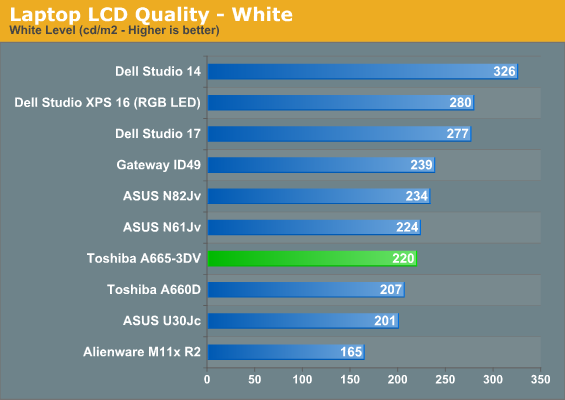
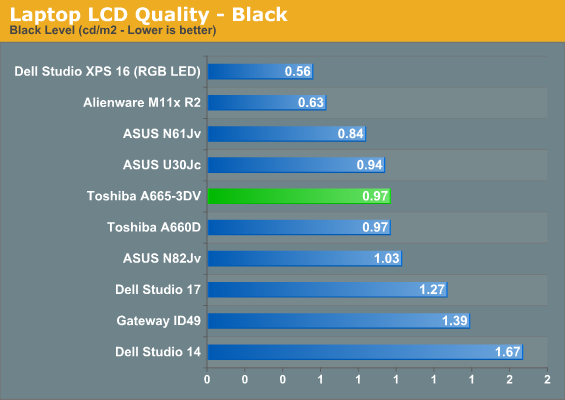
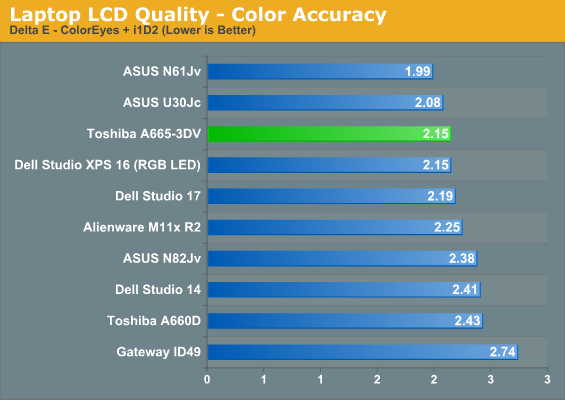


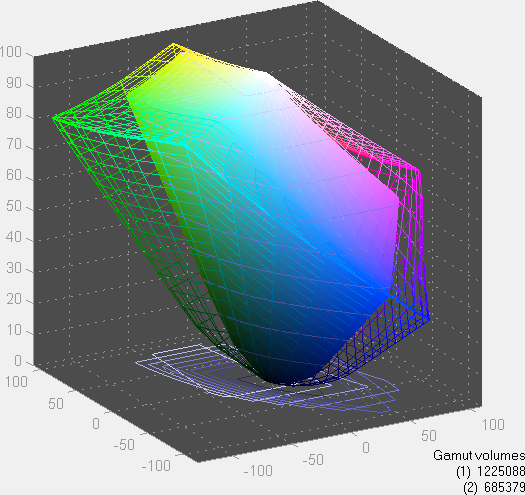
Color accuracy is okay but nothing special, while color gamut is a step up from the bottom level panels but still below the desired minimum 72% (NTSC) gamut. There's also the low 1366x768 resolution, but given the 3D features and how poorly games run in 3D even at 768p, we're not surprised Toshiba stayed away from the higher resolution panels. Also, the only other size 3D/120Hz laptop panel we're aware of is a 17.3" 1080p, so in this case the choices were extremely limited. The problem is, there's an emphasis on the 3D multimedia aspects of this notebook, and for multimedia work we'd really like a better quality LCD. Watching movies where dark scenes look more like gray isn't a great experience.
Noise and Heat
Surface temperatures are quite a bit cooler, but the left half of the laptop gets substantially warmer under load, topping out in the 40-45C range above and below the exhaust port. As you move to the right, there's a steady decline until you pass the middle of the laptop, after which the surface is in the <35C range (even under load). The bottom of the unit is typically a couple degrees warmer than the top, but nothing noteworthy. Noise levels hit a maximum of 40dB from 12", with idle noise of 33dB, which is near the limits of our equipment (30dB). Under light loads, the fan will periodically spin up and make itself heard, but it's not a major issue.
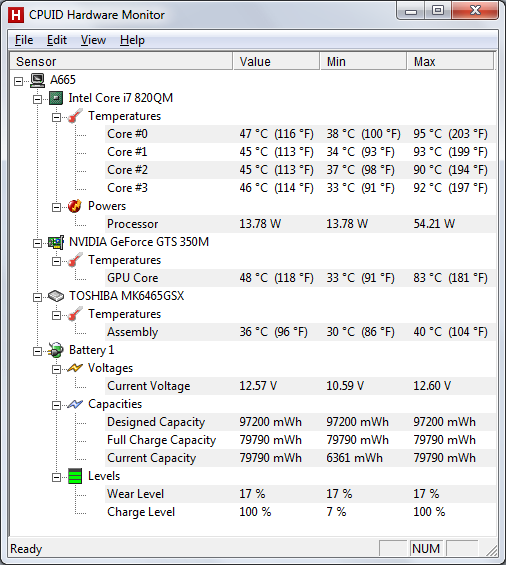
In response to a reader request, we've begun listing results from HWMonitor to show CPU/CPU core temperatures. GPU core temperature maxes out at 83C, which is fairly reasonable, while idle temperatures tend towards the upper 30s and lower 40s (the "min" result is taken shortly after powering on the system). CPU temperatures top out at 90-95C, again in spec but quite warm, with idle use hovering in the mid 40s. The hard drive also sits in the 35-40C range after the system has warmed up. One interesting item is the CPU power draw figure; we don't know how HWMonitor calculates the load, but the maximum 54.21W is 9W higher than the 740QM's 45W TDP. Whether that's accurate or not we can't say, but it is interesting nonetheless. As for the battery, the above readings were recorded after our three initial battery life tests; the first time we ran HWMonitor, wear level came up as 30%. A couple more cycles brought the wear level down to the expected range, seen below.
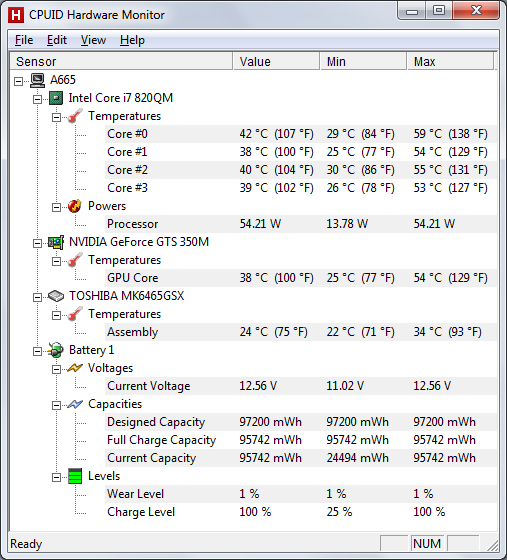
Results such as this are thankfully not the norm; most of our batteries come with an "initial" wear level of less than 3%, but the large 12-cell battery in the A665-3DV needed more time to break in. We had to rerun all the battery life tests after about five cycles, and our initial results were far worse than the final scores we showed.















13 Comments
View All Comments
Stuka87 - Wednesday, October 6, 2010 - link
What a horrible resolution. 1366x768 on a 15.6" display!? This res is almost usable on a 12-13" display (And thats pushing it), but on a 15.6"?? Is this machine tailored towards old people with vision issues or something?Ok, back to reading. Had to vent :)
Spivonious - Wednesday, October 6, 2010 - link
I agree that 768 vertical pixels is not very much to work with, but the screen here is still 100dpi, which is slightly better than the standard 96.nubie - Wednesday, October 6, 2010 - link
I for one think it is the correct choice.How is the video card to push more pixels than that anyway?
Buy a different laptop, or upgrade the panel yourself if it bugs you.
blackshard - Wednesday, October 6, 2010 - link
Thanks a lot for the hwmonitor readings! :)It's really interesting to see expected temperatures and real battery capacity in such notebooks!
Michaelsm - Wednesday, October 6, 2010 - link
Yes, Thanks a lot for the hwMonitor readings. As I commented the other day, my Toshiba (M645 with a 6 cell) had an initial wear of 36%!!! 3 cycles later it is down to 7%.cknobman - Wednesday, October 6, 2010 - link
until the industry gives up on the freaking 3D gimmick.nubie - Wednesday, October 6, 2010 - link
Have you tried it?I have made several 3D setups myself and favor passive glasses and dual monitors or projectors (1 per eye).
In many situations the 3D is stunningly immersive. Racing games for example have a fantastic feeling of speed as the depth of objects hurtle toward you.
Watching the apex of a corner approach and searching the distance for your braking point feel good. As does overtaking a slower car.
Even if you personally feel it is a gimmick, how is the industry or how are you personally caused any harm?
JarredWalton - Wednesday, October 6, 2010 - link
If you missed it in the text, we're looking to replace Peacekeeper with something that feels more relevant. Does anyone have a good "Internet benchmark" they want us to start using? Something that captures the speed of page loads, transitions, etc.?Stuka87 - Wednesday, October 6, 2010 - link
I have looked around a bit for my own reasons, and outside of the ones made by the browser makers (which are all pretty biased one way or another), there isn't much to choose from.I think I pretty much came up with just needing to write one from scratch using the browsers API with FireFox or the like.
alphadog - Wednesday, October 6, 2010 - link
I'm getting pretty tired of the lack of properly-sized LCDs on laptops. I know the LCD is one of the more costly components in margin-thin laptops, but really? 768 vert?!?